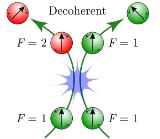
SERF
Encyclopedia
A spin exchange relaxation-free (SERF) magnetometer is a type of magnetometer
developed at Princeton University
in the early 2000s. SERF magnetometers measure magnetic fields by using lasers to detect the interaction between alkali metal
atoms in a vapor and the magnetic field.
The name for the technique comes from the fact that spin exchange relaxation, a mechanism which usually scrambles the orientation of atomic spins, is avoided in these magnetometers. This is done by using a high (1014 cm−3) density of Potassium
atoms and a very low magnetic field. Under these conditions, the atoms exchange spin quickly compared to their magnetic precession frequency so that the average spin interacts with the field and is not destroyed by decoherence.
A spin-exchange relaxation-free (SERF) magnetometer
achieves very high magnetic field sensitivity by monitoring a high density vapor of alkali metal
atoms precessing in a near-zero magnetic field.
The sensitivity of SERF magnetometers improves upon traditional atomic magnetometers by eliminating the dominant cause of atomic spin decoherence caused by spin-exchange collisions among the alkali metal
atoms. SERF magnetometers are among the most sensitive magnetic field sensors and in some cases exceed the performance of SQUID
detectors of equivalent size. A small 1 cm3 volume glass cell containing potassium vapor has reported 1 fT/√Hz sensitivity and can theoretically become even more sensitive with larger volumes.
They are vector magnetometers capable of measuring all three components of the magnetic field simultaneously.
density (at higher temperature) and in sufficiently low magnetic field.
The spin-exchange relaxation rate for atoms with low polarization experiencing slow spin-exchange can be expressed as follows:
for atoms with low polarization experiencing slow spin-exchange can be expressed as follows:
where is the time between spin-exchange collisions,
is the time between spin-exchange collisions,  is the nuclear spin,
is the nuclear spin,  is the magnetic resonance frequency,
is the magnetic resonance frequency,  is the gyromagnetic ratio for an electron.
is the gyromagnetic ratio for an electron.
In the limit of fast spin-exchange and small magnetic field, the spin-exchange relaxation rate vanishes for sufficiently small magnetic field:
where is the "slowing-down" constant to account for sharing of angular momentum between the electron and nuclear spins:
is the "slowing-down" constant to account for sharing of angular momentum between the electron and nuclear spins:


where is the average polarization of the atoms. The atoms suffering fast spin-exchange precess more slowly when they are not fully polarized because they spend a fraction of the time in different hyperfine states precessing at different frequencies (or in the opposite direction).
is the average polarization of the atoms. The atoms suffering fast spin-exchange precess more slowly when they are not fully polarized because they spend a fraction of the time in different hyperfine states precessing at different frequencies (or in the opposite direction).
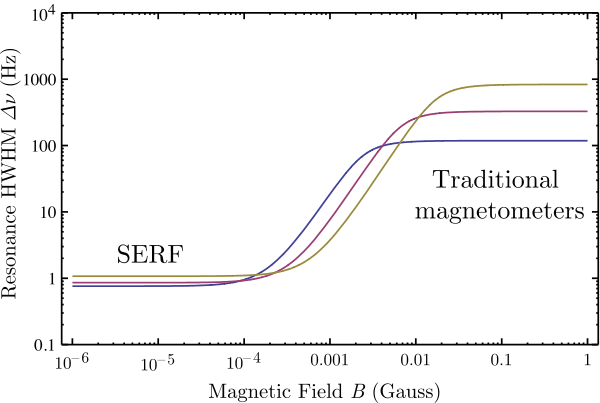
 of atomic magnetometers are limited by the number of atoms
of atomic magnetometers are limited by the number of atoms  and their spin coherence lifetime
and their spin coherence lifetime  according to
according to
where is the gyromagnetic ratio of the atom and
is the gyromagnetic ratio of the atom and  is the average polarization of total atomic spin
is the average polarization of total atomic spin  .
.
In the absence of spin-exchange relaxation, a variety of other relaxation mechanisms contribute to the decoherence of atomic spin:
where is the relaxation rate due to collisions with the cell walls and
is the relaxation rate due to collisions with the cell walls and  are the spin destruction rates for collisions among the alkali metal
are the spin destruction rates for collisions among the alkali metal
atoms and collisions between alkali atoms and any other gasses that may be present.
In an optimal configuration, a density of 1014 cm−3 potassium atoms in a 1 cm3 vapor cell with ~3 atm helium buffer gas can achieve 10 aT Hz-1/2 (10−17 T Hz-1/2) sensitivity with relaxation rate ≈ 1 Hz.
≈ 1 Hz.
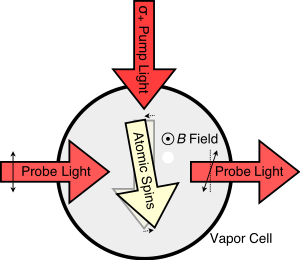 Alkali metal vapor of sufficient density is obtained by simply heating solid alkali metal inside the vapor cell. A typical SERF atomic magnetometer can take advantage of low noise diode lasers to polarize and monitor spin precession. Circularly polarized pumping light tuned to the
Alkali metal vapor of sufficient density is obtained by simply heating solid alkali metal inside the vapor cell. A typical SERF atomic magnetometer can take advantage of low noise diode lasers to polarize and monitor spin precession. Circularly polarized pumping light tuned to the  spectral resonance line polarizes the atoms. An orthogonal probe beam detects the precession using optical rotation of linearly polarized light. In a typical SERF magnetometer, the spins merely tip by a very small angle because the precession frequency is slow compared to the relaxation rates.
spectral resonance line polarizes the atoms. An orthogonal probe beam detects the precession using optical rotation of linearly polarized light. In a typical SERF magnetometer, the spins merely tip by a very small angle because the precession frequency is slow compared to the relaxation rates.
magnetometers for use in a variety of applications. The SERF magnetometer has the following advantages:
Potential disadvantages:
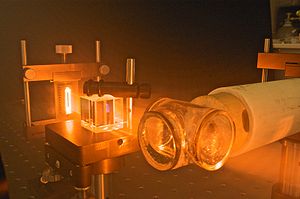 The SERF magnetometer was developed by Michael V. Romalis at Princeton University
The SERF magnetometer was developed by Michael V. Romalis at Princeton University
in the early 2000s. The underlying physics governing the suppression spin-exchange relaxation was developed decades earlier by William Happer
but the application to magnetic field measurement was not explored at that time. The name "SERF" was partially motivated by its relationship to SQUID detectors in a marine metaphor.
Magnetometer
A magnetometer is a measuring instrument used to measure the strength or direction of a magnetic field either produced in the laboratory or existing in nature...
developed at Princeton University
Princeton University
Princeton University is a private research university located in Princeton, New Jersey, United States. The school is one of the eight universities of the Ivy League, and is one of the nine Colonial Colleges founded before the American Revolution....
in the early 2000s. SERF magnetometers measure magnetic fields by using lasers to detect the interaction between alkali metal
Alkali metal
The alkali metals are a series of chemical elements in the periodic table. In the modern IUPAC nomenclature, the alkali metals comprise the group 1 elements, along with hydrogen. The alkali metals are lithium , sodium , potassium , rubidium , caesium , and francium...
atoms in a vapor and the magnetic field.
The name for the technique comes from the fact that spin exchange relaxation, a mechanism which usually scrambles the orientation of atomic spins, is avoided in these magnetometers. This is done by using a high (1014 cm−3) density of Potassium
Potassium
Potassium is the chemical element with the symbol K and atomic number 19. Elemental potassium is a soft silvery-white alkali metal that oxidizes rapidly in air and is very reactive with water, generating sufficient heat to ignite the hydrogen emitted in the reaction.Potassium and sodium are...
atoms and a very low magnetic field. Under these conditions, the atoms exchange spin quickly compared to their magnetic precession frequency so that the average spin interacts with the field and is not destroyed by decoherence.
A spin-exchange relaxation-free (SERF) magnetometer
Magnetometer
A magnetometer is a measuring instrument used to measure the strength or direction of a magnetic field either produced in the laboratory or existing in nature...
achieves very high magnetic field sensitivity by monitoring a high density vapor of alkali metal
Alkali metal
The alkali metals are a series of chemical elements in the periodic table. In the modern IUPAC nomenclature, the alkali metals comprise the group 1 elements, along with hydrogen. The alkali metals are lithium , sodium , potassium , rubidium , caesium , and francium...
atoms precessing in a near-zero magnetic field.
The sensitivity of SERF magnetometers improves upon traditional atomic magnetometers by eliminating the dominant cause of atomic spin decoherence caused by spin-exchange collisions among the alkali metal
Alkali metal
The alkali metals are a series of chemical elements in the periodic table. In the modern IUPAC nomenclature, the alkali metals comprise the group 1 elements, along with hydrogen. The alkali metals are lithium , sodium , potassium , rubidium , caesium , and francium...
atoms. SERF magnetometers are among the most sensitive magnetic field sensors and in some cases exceed the performance of SQUID
SQUID
A SQUID is a very sensitive magnetometer used to measure extremely weak magnetic fields, based on superconducting loops containing Josephson junctions....
detectors of equivalent size. A small 1 cm3 volume glass cell containing potassium vapor has reported 1 fT/√Hz sensitivity and can theoretically become even more sensitive with larger volumes.
They are vector magnetometers capable of measuring all three components of the magnetic field simultaneously.
Spin-exchange relaxation
Spin-exchange collisions preserve total angular momentum of a colliding pair of atoms but can scramble the hyperfine state of the atoms. Atoms in different hyperfine states do not precess coherently and thereby limit the coherence lifetime of the atoms. However, decoherence due to spin-exchange collisions can be nearly eliminated if the spin-exchange collisions occur much faster than the precession frequency of the atoms. In this regime of fast spin-exchange, all atoms in an ensemble rapidly change hyperfine states, spending the same amounts of time in each hyperfine state and causing the spin ensemble to precess more slowly but remain coherent. This so-called SERF regime can be reached by operating with sufficiently high alkali metalAlkali metal
The alkali metals are a series of chemical elements in the periodic table. In the modern IUPAC nomenclature, the alkali metals comprise the group 1 elements, along with hydrogen. The alkali metals are lithium , sodium , potassium , rubidium , caesium , and francium...
density (at higher temperature) and in sufficiently low magnetic field.
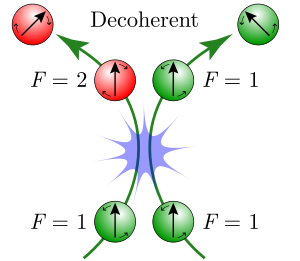 | 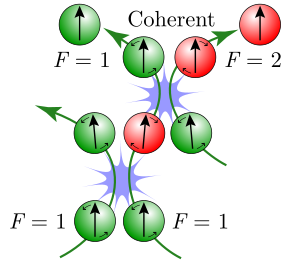 |
The spin-exchange relaxation rate
 for atoms with low polarization experiencing slow spin-exchange can be expressed as follows:
for atoms with low polarization experiencing slow spin-exchange can be expressed as follows:
where
 is the time between spin-exchange collisions,
is the time between spin-exchange collisions,  is the nuclear spin,
is the nuclear spin,  is the magnetic resonance frequency,
is the magnetic resonance frequency,  is the gyromagnetic ratio for an electron.
is the gyromagnetic ratio for an electron.In the limit of fast spin-exchange and small magnetic field, the spin-exchange relaxation rate vanishes for sufficiently small magnetic field:

where
 is the "slowing-down" constant to account for sharing of angular momentum between the electron and nuclear spins:
is the "slowing-down" constant to account for sharing of angular momentum between the electron and nuclear spins:


where
 is the average polarization of the atoms. The atoms suffering fast spin-exchange precess more slowly when they are not fully polarized because they spend a fraction of the time in different hyperfine states precessing at different frequencies (or in the opposite direction).
is the average polarization of the atoms. The atoms suffering fast spin-exchange precess more slowly when they are not fully polarized because they spend a fraction of the time in different hyperfine states precessing at different frequencies (or in the opposite direction).
Sensitivity
The sensitivity of atomic magnetometers are limited by the number of atoms
of atomic magnetometers are limited by the number of atoms  and their spin coherence lifetime
and their spin coherence lifetime  according to
according to
where
 is the gyromagnetic ratio of the atom and
is the gyromagnetic ratio of the atom and  is the average polarization of total atomic spin
is the average polarization of total atomic spin  .
.In the absence of spin-exchange relaxation, a variety of other relaxation mechanisms contribute to the decoherence of atomic spin:

where
 is the relaxation rate due to collisions with the cell walls and
is the relaxation rate due to collisions with the cell walls and  are the spin destruction rates for collisions among the alkali metal
are the spin destruction rates for collisions among the alkali metalAlkali metal
The alkali metals are a series of chemical elements in the periodic table. In the modern IUPAC nomenclature, the alkali metals comprise the group 1 elements, along with hydrogen. The alkali metals are lithium , sodium , potassium , rubidium , caesium , and francium...
atoms and collisions between alkali atoms and any other gasses that may be present.
In an optimal configuration, a density of 1014 cm−3 potassium atoms in a 1 cm3 vapor cell with ~3 atm helium buffer gas can achieve 10 aT Hz-1/2 (10−17 T Hz-1/2) sensitivity with relaxation rate
 ≈ 1 Hz.
≈ 1 Hz.Typical operation

 spectral resonance line polarizes the atoms. An orthogonal probe beam detects the precession using optical rotation of linearly polarized light. In a typical SERF magnetometer, the spins merely tip by a very small angle because the precession frequency is slow compared to the relaxation rates.
spectral resonance line polarizes the atoms. An orthogonal probe beam detects the precession using optical rotation of linearly polarized light. In a typical SERF magnetometer, the spins merely tip by a very small angle because the precession frequency is slow compared to the relaxation rates.Advantages and disadvantages
SERF magnetometers compete with SQUIDSQUID
A SQUID is a very sensitive magnetometer used to measure extremely weak magnetic fields, based on superconducting loops containing Josephson junctions....
magnetometers for use in a variety of applications. The SERF magnetometer has the following advantages:
- Equal or better sensitivity per unit volume
- Cryogen-free operation
- All-optical measurement limits enables imaging and eliminates interference.
Potential disadvantages:
- Can only operate near zero field.
- Sensor vapor cell must be heated.
Applications
Applications utilizing high sensitivity of SERF magnetometers potentially include:- High-performance magnetoencephalographic imagingMagnetoencephalographyMagnetoencephalography is a technique for mapping brain activity by recording magnetic fields produced by electrical currents occurring naturally in the brain, using arrays of SQUIDs...
. - Sample magnetization measurement, especially rock samples.
History

Princeton University
Princeton University is a private research university located in Princeton, New Jersey, United States. The school is one of the eight universities of the Ivy League, and is one of the nine Colonial Colleges founded before the American Revolution....
in the early 2000s. The underlying physics governing the suppression spin-exchange relaxation was developed decades earlier by William Happer
William Happer
William Happer is a physicist who has specialised in the study of optics and spectroscopy. He is the Cyrus Fogg Brackett Professor of Physics at Princeton University.-Education:...
but the application to magnetic field measurement was not explored at that time. The name "SERF" was partially motivated by its relationship to SQUID detectors in a marine metaphor.
External links
- Photographs of a SERF magnetometer from the Romalis Group at Princeton University.

